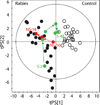Metabolomics of cerebrospinal fluid from humans treated for rabies
- PMID: 23163834
- PMCID: PMC4824192
- DOI: 10.1021/pr3009176
Metabolomics of cerebrospinal fluid from humans treated for rabies
Abstract
Rabies is a rapidly progressive lyssavirus encephalitis that is statistically 100% fatal. There are no clinically effective antiviral drugs for rabies. An immunologically naïve teenager survived rabies in 2004 through improvised supportive care; since then, 5 additional survivors have been associated with use of the so-called Milwaukee Protocol (MP). The MP applies critical care focused on the altered metabolic and physiologic states associated with rabies. The aim of this study was to examine the metabolic profile of cerebrospinal fluid (CSF) from rabies patients during clinical progression of rabies encephalitis in survivors and nonsurvivors and to compare these samples with control CSF samples. Unsupervised clustering algorithms distinguished three stages of rabies disease and identified several metabolites that differentiated rabies survivors from those who subsequently died, in particular, metabolites related to energy metabolism and cell volume control. Moreover, for those patients who survived, the trajectory of their metabolic profile tracked toward the control profile and away from the rabies profile. NMR metabolomics of human rabies CSF provide new insights into the mechanisms of rabies pathogenesis, which may guide future therapy of this disease.
Figures



Similar articles
-
Current and future approaches to the therapy of human rabies.Antiviral Res. 2013 Jul;99(1):61-7. doi: 10.1016/j.antiviral.2013.01.003. Epub 2013 Jan 29. Antiviral Res. 2013. PMID: 23369672 Review.
-
Presumptive abortive human rabies - Texas, 2009.MMWR Morb Mortal Wkly Rep. 2010 Feb 26;59(7):185-90. MMWR Morb Mortal Wkly Rep. 2010. PMID: 20186117
-
Immunogenicity and efficacy of Fermi-type nerve tissue rabies vaccine in mice and in humans undergoing post-exposure prophylaxis for rabies in Ethiopia.Ethiop Med J. 2001 Oct;39(4):313-21. Ethiop Med J. 2001. PMID: 12380231 Clinical Trial.
-
Antiviral therapy for human rabies.Antivir Ther. 2015;20(1):1-10. doi: 10.3851/IMP2851. Epub 2014 Aug 26. Antivir Ther. 2015. PMID: 25156675 Review.
-
In vitro and in vivo evaluation of a single chain antibody fragment generated in planta with potent rabies neutralisation activity.Vaccine. 2019 Aug 2;37(33):4673-4680. doi: 10.1016/j.vaccine.2018.02.057. Epub 2018 Mar 6. Vaccine. 2019. PMID: 29523449 Free PMC article.
Cited by
-
Cerebrospinal fluid metabolomics: detection of neuroinflammation in human central nervous system disease.Clin Transl Immunology. 2021 Aug 6;10(8):e1318. doi: 10.1002/cti2.1318. eCollection 2021. Clin Transl Immunology. 2021. PMID: 34386234 Free PMC article. Review.
-
Assessing Repeated Urinary Proline Betaine Measures as a Biomarker of Usual Citrus Intake during Pregnancy: Sources of Within-Person Variation and Correlation with Reported Intake.Metabolites. 2023 Aug 2;13(8):904. doi: 10.3390/metabo13080904. Metabolites. 2023. PMID: 37623848 Free PMC article.
-
Diagnosis, management and post-mortem findings of a human case of rabies imported into the United Kingdom from India: a case report.Virol J. 2014 Apr 7;11:63. doi: 10.1186/1743-422X-11-63. Virol J. 2014. PMID: 24708671 Free PMC article.
-
Mass-spectrometric profiling of cerebrospinal fluid reveals metabolite biomarkers for CNS involvement in varicella zoster virus reactivation.J Neuroinflammation. 2018 Jan 17;15(1):20. doi: 10.1186/s12974-017-1041-0. J Neuroinflammation. 2018. PMID: 29343258 Free PMC article.
-
Long-term effects of western diet consumption in male and female mice.Sci Rep. 2020 Sep 7;10(1):14686. doi: 10.1038/s41598-020-71592-9. Sci Rep. 2020. PMID: 32895402 Free PMC article.
References
-
- Committee on Infectious Diseases. Rabies-prevention policy update: new reduced-dose schedule. Pediatrics. 2011;127(4):785–787. - PubMed
-
- World Health Organization. WHO expert consultation on rabies. Geneva: World Health Organization; 2005. - PubMed
-
- Hattwick MA, Weis TT, Stechschulte CJ, Baer GM, Gregg MB. Recovery from rabies. A case report. Ann. Intern. Med. 1972;76(6):931–942. - PubMed
-
- Porra SC, Barboza JJ, Fuenzalida E, Adaros HL, Oviedo AM, Furst J. Recovery from rabies in man. Ann. Intern. Med. 1976;85(1):44–48. - PubMed
Publication types
MeSH terms
Substances
Grants and funding
LinkOut - more resources
Full Text Sources
Medical
Molecular Biology Databases

